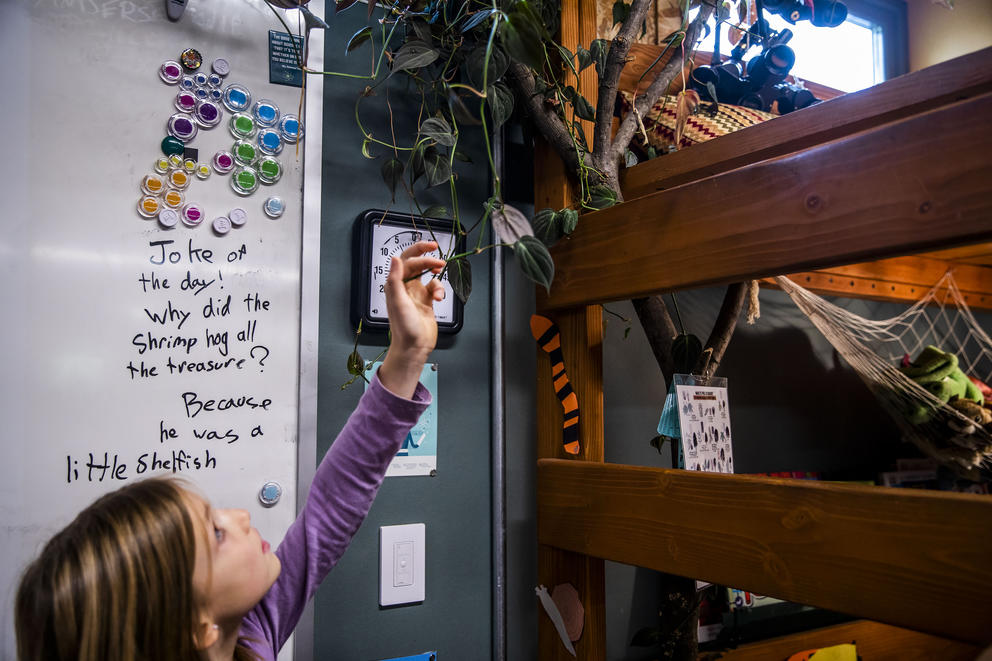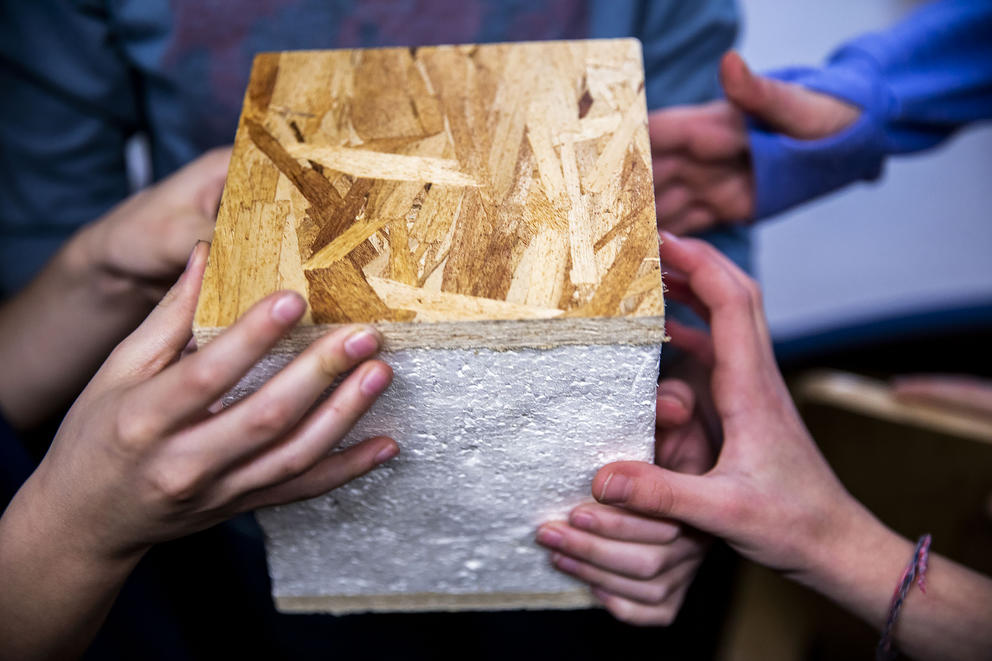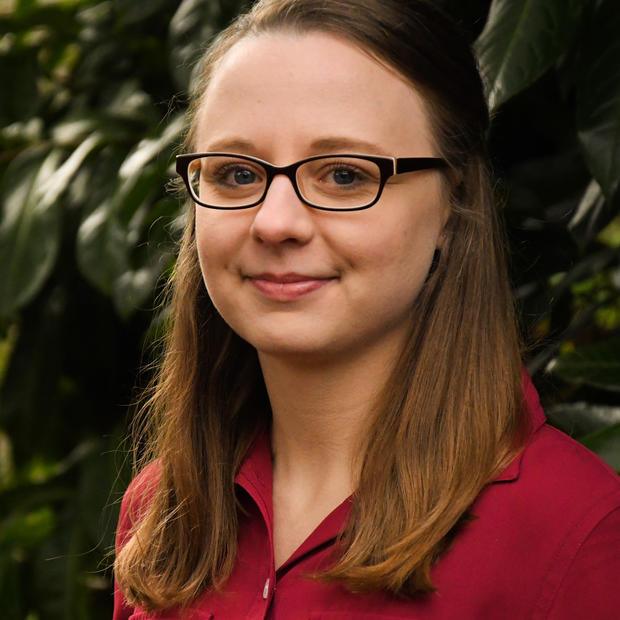In a school known for its hands-on, inquiry-based learning (its website warns parents that “the Perkins experience can be quite messy!”), a one-story building with all of its inner workings on display outside of its walls seemed like a natural fit. But four years on, Perkins students and teachers have a deeper understanding for how an emphasis on being green can transform a school’s curriculum and learning environment.
The K-5 independent school had been spending a year searching for a space for science and technology classes when administrators led by Head of School Barry Wright spotted an 860-square-foot Living Building classroom at The Living Future Unconference. After meeting with SEED Collaborative designers and getting board approval, the school bought and installed a modular SEED classroom in its parking lot — believed to be the first of its kind in the world.
At 28 by 32 feet, the slate gray and green building consists of one large room big enough to comfortably hold as many as 40 students, and a small bathroom. Inside the rectangular building, the walls are made of Oriented Strand Board (an engineered wood similar to particle board) and covered in pipes and wiring that are all safe for curious hands. Books, diagrams and canvas signs pointing out certain facts about the classroom decorate the walls. “This water tank, or cistern, is full of water collected from the roof, and provides the water needed in the classroom,” reads one sign. The strand board, many plants, and non-toxic materials used to build it give the space a fresh, natural smell. Science and technology teacher Zoë Dash spends her days in the SEED classroom, and she says students new to the classroom comment on it on a daily basis.
“[They say] the air just smells better in here,” Dash says.
The classroom’s roof is covered in solar panels — enough to power everything from lights to heat to venting to the robot Dash and Dot, which helps teach programming skills to the second through fifth graders. The roof inclines so rainwater travels through its gutter system before collecting in a large outdoor cistern. The cistern connects to a smaller indoor cistern that runs water through a filtration system and then into a classroom sink. The structure also has a bathroom with a compostable toilet (although the bathroom sink follows code and uses water from a potable source). The entire building is constructed from materials that are LEED certified and non-toxic.
Last year, the SEED classroom notched another milestone by being classified as a Living Building — a prestigious international certification that shows it meets certain stringent environmental requirements, including using rain for all water needs and independently generating all electricity. But for Dash, who calls the classroom her “pride and joy,” the certification is a footnote to its greater contribution to school culture. Its array of green technology has seeped into the very fabric of the school, infiltrating everything from its curriculum and surrounding classrooms to the terms facility and parents use to describe the school.
“We’re not a math and science school — we’re a math, sustainability and science school,” said Wright. “I just feel like it has to be part of our definition now.”
Its physical attributes are spreading, too: Earlier this month, Perkins officially opened a new wing directly inspired by the SEED classroom.
Three new rooms were built on top of an expanded gym in order to make room for a growing student body (about 80 students). But rather than just constructing traditional city-powered spaces, Perkins borrowed some of the modular classroom’s green systems. They even polled 4th and 5th graders for suggestions as to which sustainable systems should be included in the school’s expansion and the kids then presented those ideas to Wright.
Some innovative choices made the cut. One new classrooms sports a giant mirror on its roof that aims sunlight through a ceiling window in order to brighten the classroom without using electric lights during the day. Another classroom includes a solar panel to power the lights in the room, along with a large switch that students manually flip when traditional electricity is needed. Wright said it’s meant to give the students a fun, interactive way to learn about where the classroom’s power is coming from.
“We just want to make the whole thing as visual and understandable as possible,” he said.
The third classroom, a shared space called the Green Room, connects to another cistern so rainwater can supply its sink. It will also eventually feature a substantial collection of plants, including a hydroponic gardening system fed by rainwater (a student suggestion).
But Dash says the SEED classroom provides the greatest impact on her teaching. The purposeful exposure of the classroom’s many green systems so that students can see, interact with and learn from them offers endless opportunities for students to indulge in tactile curiosity and learning.
“They didn’t cover things up with the typical ceiling panels or paint over most of the walls,” she said. “The architects had in mind leaving it exposed to not be a passive room to teach in but have the room itself be part of the teaching process.”
Since starting to teach in the space in the fall of 2014, Dash said she has increased the number of units she offers that incorporate the building as a main class focus from zero to six and counting.
One month-long unit for 2nd and 3rd graders concentrates on materials used in the building. Dash assigns her students a "materials hunt" wherein they explore the entire school and write down what they find — like metal, glass or carpet. Then she asks them to match pictures of those materials with pictures of natural resources to learn about their origins and impact on ecosystems.
The assignment doesn’t end there. Dash includes a follow-up lesson where kids learn where those materials go once we’re done using them, and how long they take to biodegrade. An examination of a chunk of the SEED classroom’s 10-inch-thick, plant-based Styrofoam insulation is particularly instructive.
“It still works as insulation and stays strong inside our walls for as long as we need it to, but then can biodegrade faster when it's time,” she tells the students.
Fourth and fifth graders learn about each of the seven performance areas, or “petals,” that define the Living Building Challenge: place, water, energy, materials, equity, beauty and health/happiness. This advanced unit ends with the students choosing a building from the neighborhood and redesigning it as a Living Building. The assignment allows kids to tap into their personal creativity: One student depicted a converted fire station with electric trucks, plants and a cistern; another designed a donut shop with a bike ramp and a water-permeable parking lot aimed at preventing runoff. Dash even encourages the students to present their projects to the staff of the businesses they chose.
Just existing in the SEED classroom everyday forces students to interact with its many systems and be more conscious of its processes. By doing something as mundane as turning on the sink to wash their hands, students will hear the water system’s pump trigger.
“They’re suddenly being drawn to where is this water coming from. They can think, ‘OK where is it going next,’ and they can follow that pipe,” Dash said.
With a new green wing up and running, the faculty is looking for ways to incorporate a whole new section of green technology into the curriculum. If the SEED classroom is any guide, students will absorb lessons in sustainability without any formal lessons.
In the new Green Room, for instance, students can discover half-dollar-sized generators hooked into the filtration system that operate together like a miniature hydroelectric plant. They “show that just having pressurized water push through, these generators will generate a little bit of electricity,” said Wright.
It is these types of special educational touches that have left the school with students who not only understand about conservation and green engineering, but are also prepared to apply those concepts to the outside world. Already, students have internalized the green classroom’s benefits to the point that they have started to question their surroundings.
Dash said when she takes the 4th and 5th graders on walks around the neighborhood, some have started critiquing buildings that fail to incorporate sustainable design features. In one instance, a student asked why a particular home didn’t collect rainwater off its roof, while another wondered about a driveway that failed to use gravel so it could be more permeable.
They were “thinking about how they’d apply those ideas, and kind of incredulous that other buildings aren’t doing those things yet,” she said.






